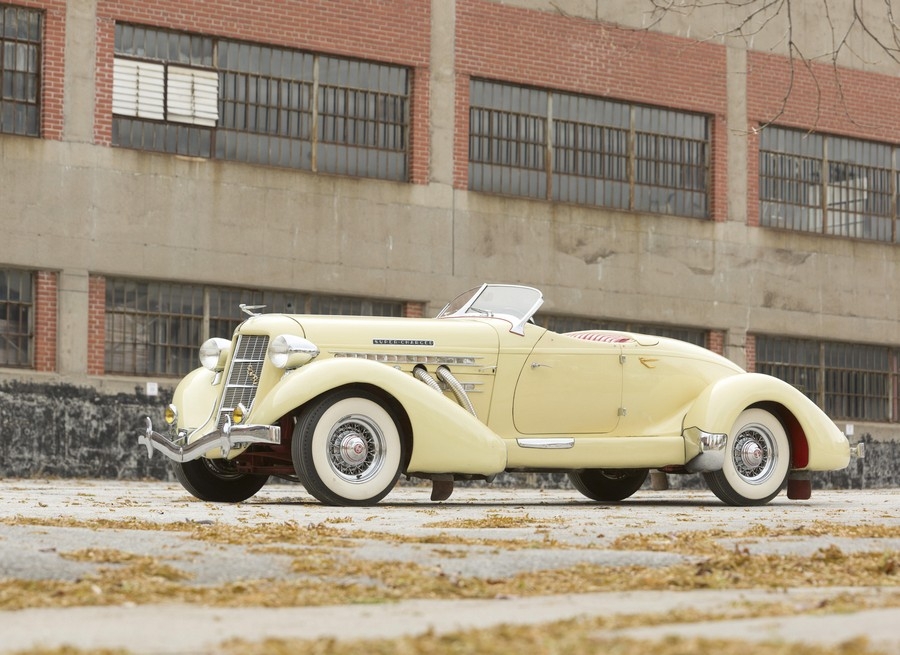SCM Analysis
Detailing
| Vehicle: | 1935 Auburn 851 Boattail Speedster |
| Original List Price: | $2,245 |
| Tune Up Cost: | $300 |
| Distributor Caps: | $75 |
| Chassis Number Location: | On the right frame rail |
| Engine Number Location: | On the left side of the block |
| Club Info: | ACD Club, CCCA |
| Website: | http://www.acdclub.org |
| Alternatives: | 1930 Packard 734 Boattail, 1931 Hudson T119 Boattail Speedster, 1934 Duesenberg Model J Boattail Speedster |
| Investment Grade: | A |
This car, Lot 142, sold for $467,500, including buyer’s premium, at Bonhams’ Scottsdale auction on January 14, 2014.
The success — and the eventual demise — of Auburn lie with Errett Lobban Cord. As a brash used-car salesman from the Moon Motor Car Company, he was hired at the desperate Auburn Automobile Company and by adding a little “sizzle to the steak,” moved the unsold inventory — turning a $500,000 profit along the way. Sales doubled in 1925 and again in 1926, and he became the president. His vision for Auburn was racy styling and exceptional performance at value pricing.
The Auburn Automobile Company prospered for several years, but the Great Depression soon took its toll. By 1933, sales had dropped to 6,000 cars. The V12 was dropped and the 6-cylinder model returned. Sales did not respond, and E.L. Cord no longer had his heart in the program. So he moved to England and his automotive empire languished.
In the midst of the Great Depression, performance and dramatic styling did not sell cars, and production of the Auburn ended in October of 1936. However, during the company’s short life, Auburn produced three iterations of the Speedster, perhaps the most dramatic American car produced in the Classic Era.
Speedster history
The first Auburn Speedster, introduced in 1928, was derived from the 1927 Duesenberg Model X Speedster. The design, accredited by some to Count Alexis de Sakhnoffsky, had sharply raked doors and windshield and a narrow two-passenger body. It set a new one-mile speed record of 108.460 mph for stock cars at Daytona Beach. While this feat brought people into the showroom, only 226 Auburn Speedsters were produced in 1928. Production continued into 1929 but was dropped for 1930.
Alan Huet Leamy, after a stint at Marmon, joined Cord in April 1928 as a designer. Leamy was looking for design work with a little more flair, and he was put to work on the Duesenberg Model J and the Cord L-29.
His next project was to create a completely new design for the 1931 Auburn line. The Speedster was back in the lineup late in the year, and Leamy redesigned it with a boattail rear end and a raked windshield, making it one of the most elegant Auburns produced. The Speedster was offered as an Eight or Twelve in three trim lines, but only 20 were produced in 1933 and those sold the following year were thought to be leftovers. Leamy was the scapegoat for the disastrous 1934 sales year, and he soon moved on to the Fisher Body Company.
Gordon Buehrig, who had worked at Dietrich, Packard and for Harley Earl at General Motors, was brought in to give the Auburn line a facelift.
Buehrig designed a new hood and massive radiator shell and grille while eliminating the descending beltline. A supercharged version of the Lycoming 8-cylinder engine, which produced 150 horsepower, was installed in the revamped Speedster. Each Speedster was equipped with a plate on the dash stating that the car had been driven 100-plus miles per hour. This was a sales gimmick, as the plaques were attached to the dashes prior to assembly. It is not known how many 1935–36 Speedsters were produced, and estimates range from 150 to 500.
Our subject car was found in an old garage in Omaha, NE, in 1949, and it was restored in 1951. To update the car, a 1936 852 ID plate was added and the radiator script changed to 852, a practice dealers followed in the era with their leftover inventory. It was driven extensively until after a race in which it beat a Duesenberg SJ, when it was determined that the head was cracked. It was parked and did not move for 52 years.
A bruised, beautiful original
The car, as to be expected, shows the bruises of time. The upholstery is worn, the trim is pitted here and there and the paint is cracked and aging. However, this Speedster is marvelously original. The car has the correct headlamp lenses, with the pimple on the crown. It also has the correct exhaust manifold, which looks like it was made by a high school welding class. An NOS replacement head is with the car, so it can be put in running order with little effort.
Not that many years ago, the first stop the new owner would make would be to the restoration shop for a total frame-off restoration. With the current values of Auburn Speedsters, a complete restoration would even be financially prudent today, but respect — and value — for original cars has heightened. It can always be restored, and we just hope the new owner does not rush into a decision that he will later regret. Well bought. ♦
(Introductory description courtesy of Bonhams.)
[nggallery id=240]
